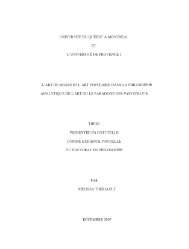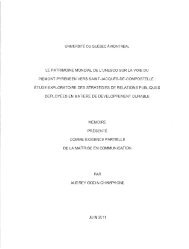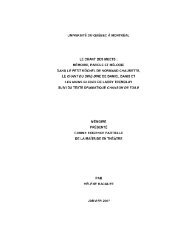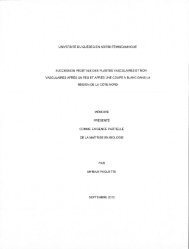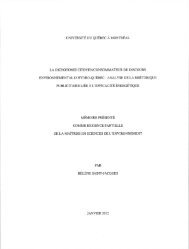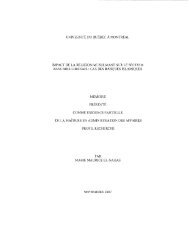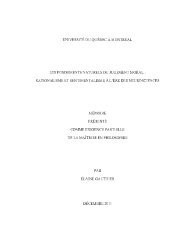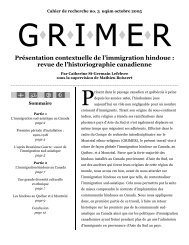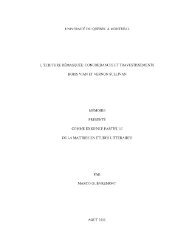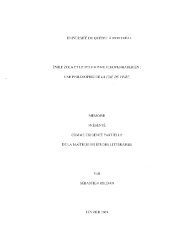Le conte de fées littéraire féminin de la fin du XVIIe siècle - Archipel
Le conte de fées littéraire féminin de la fin du XVIIe siècle - Archipel
Le conte de fées littéraire féminin de la fin du XVIIe siècle - Archipel
You also want an ePaper? Increase the reach of your titles
YUMPU automatically turns print PDFs into web optimized ePapers that Google loves.
<strong>fin</strong> <strong>du</strong> XVIf <strong>siècle</strong>: <strong>la</strong> mo<strong>de</strong> <strong>de</strong>s <strong>conte</strong>s <strong>de</strong> <strong>fées</strong> (1685-1700)13, <strong>la</strong> plupart <strong>de</strong>s étu<strong>de</strong>s<br />
concernant plus précisément le <strong>conte</strong> <strong>du</strong> XVII" <strong>siècle</strong> se sont portées sur Perrault dont le<br />
recuei l, Histoires ou Contes <strong>du</strong> temps passé, a connu, on le sait, une immense fortune<br />
<strong>littéraire</strong> '4.<br />
La critique a redécouvert, <strong>de</strong>puis une vingtaine d'années, les œuvres <strong>de</strong> <strong>conte</strong>uses<br />
<strong>conte</strong>mporaines <strong>de</strong> Perrault. Madame d'Aulnoy, <strong>la</strong> plus pro<strong>du</strong>ctive <strong>de</strong> toutes, a récemment<br />
fait l'objet <strong>de</strong> plusieurs monographies ls . <strong>Le</strong>s étu<strong>de</strong>s portant sur les autres <strong>conte</strong>uses se font<br />
surtout dans une visée féministe l6 . Si Jacques Barchilon entreprend, dans <strong>Le</strong> <strong>conte</strong><br />
merveilleux français <strong>de</strong> 1690 à 1790, cent ans <strong>de</strong> féerie et <strong>de</strong> poésie ignorées <strong>de</strong> l'histoire<br />
Iitléraire 17 , un examen <strong>du</strong> <strong>conte</strong> <strong>de</strong> <strong>fées</strong> <strong>littéraire</strong>, il ne fait que ponctuellement cas <strong>de</strong> son<br />
caractère historique. Seu le Raymon<strong>de</strong> Robert, dans son ouvrage toujours considéré par <strong>la</strong><br />
critique comme l'un <strong>de</strong>s plus importants sur le genre féerique, considère l'apparition <strong>de</strong>s<br />
premiers <strong>conte</strong>s dans un <strong>conte</strong>xte social lié à une mo<strong>de</strong> <strong>féminin</strong>e et mondaine. L'auteure, qui<br />
s'attar<strong>de</strong> sur <strong>la</strong> question <strong>de</strong>s sources omise par Jacques Barchilon, néglige cependant une<br />
compréhension esthétique ou morale <strong>de</strong>s <strong>conte</strong>s.<br />
Procédant à partir d'un corpus comprenant les œuvres <strong>de</strong> cinq <strong>conte</strong>uses <strong>de</strong> <strong>la</strong> <strong>fin</strong> <strong>du</strong><br />
XVII" <strong>siècle</strong>, nous abor<strong>de</strong>rons conjointement ces questions re<strong>la</strong>tives aux origines et à <strong>la</strong><br />
formation <strong>du</strong> genre, à J'esthétique qui en sous-tend l'écriture et à <strong>la</strong> morale, comprise dans<br />
une étu<strong>de</strong> plus générale sur <strong>la</strong> rhétorique <strong>de</strong>s <strong>conte</strong>s <strong>féminin</strong>s. Nous tenterons <strong>de</strong> montrer<br />
comment <strong>de</strong>s femmes, auxquelles tout droit à l'instruction a longtemps été dénié, s'imposent<br />
comme auteures en adaptant un matériau popu<strong>la</strong>ire oral pour en faire un genre <strong>littéraire</strong>, le<br />
n Mary Elisabeth Storer, Un épiso<strong>de</strong> lilléraire <strong>de</strong> <strong>la</strong> <strong>fin</strong> <strong>du</strong> XVI! <strong>siècle</strong>: <strong>la</strong> mo<strong>de</strong> <strong>de</strong>s <strong>conte</strong>s <strong>de</strong> <strong>fées</strong>,<br />
(1685-/700), Paris, H. Champion, 1928.<br />
14 Nous pensons notamment aux étu<strong>de</strong>s que Marc Soriano a effectué sur le <strong>conte</strong>ur: Marc Soriano, <strong>Le</strong>s<br />
<strong>conte</strong>s <strong>de</strong> Perrault: culture savante et traditions popu<strong>la</strong>ires, Paris, Gallimard, 1968.<br />
IS Il s'agit <strong>de</strong>s œuvres d'Anne Defrance, <strong>Le</strong>s <strong>conte</strong>s <strong>de</strong> <strong>fées</strong> et les nouvelles <strong>de</strong> Madame d'Aulnoy, op.<br />
cit. ; <strong>de</strong> Marie-Agnès Thirard, <strong>Le</strong>s <strong>conte</strong>s <strong>de</strong> <strong>fées</strong> <strong>de</strong> Madame d'Aulnoy: une écriture <strong>de</strong> subversion,<br />
Villeneuve d'Ascq, Presses universitaires <strong>du</strong> septentrion, J998 et <strong>de</strong> Nadine Jasmin, Naissance <strong>du</strong><br />
<strong>conte</strong> <strong>féminin</strong>. Mots et merveilles: les <strong>conte</strong>s <strong>de</strong> <strong>fées</strong> <strong>de</strong> Madame d'Aulnoy (/690-/698), Paris, H.<br />
Champion, 2002.<br />
16 Voir surtout Carl <strong>Le</strong>wis Seifert, Fairy Tales, Sexuality and Gen<strong>de</strong>r in France, /690-17/5: nostalgie<br />
Utopias, Cambridge, Cambridge University Press, 1996; Patricia Hannon, Fabulous I<strong>de</strong>ntifies:<br />
Women 's Fairy Tales in seventeenth-eentury France, Amsterdam, Rodopi, 1998, et Sophie Raynard,<br />
La secon<strong>de</strong> préciosité: floraison <strong>de</strong> <strong>conte</strong>uses <strong>de</strong> /690 à /756, Tübingen, G. Narr, 2002.<br />
17 Jacques Barchilon, <strong>Le</strong> <strong>conte</strong> merveilleux français <strong>de</strong> /690 à 1790, eent ans <strong>de</strong> féerie et <strong>de</strong> poésie<br />
ignorées <strong>de</strong> l'histoire /illéraire, Paris, H. Champion, 1975.<br />
4



